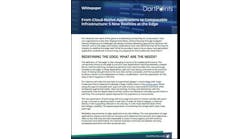PARK CITY, Utah -The combination of record leasing and uncertain delivery timelines for new data centers could be a headache for enterprise companies, who may wind up competing for space with hyperscale operators.
That presents challenges for enterprise IT operations seeking to expand, according to experts at JLL, who discussed the issue at its recent Data Center Summit.
Data center developers in a growing number of markets are facing power constraints that could slow the delivery of new capacity. Ongoing supply chain issues are also creating uncertainty about construction timetables.
Meanwhile, hyperscale computing players continue to lease record amounts of data center capacity, in many cases pre-leasing entire buildings while they are still under construction.
“If you’re not taking action now, you’re falling behind,” said Curt Holcomb, Executive Vice President, Data Centers at JLL.
“Enterprises will lose out if they delay,” said Jeff Groh, Vice Chairman at JLL, who tracks the Virginia market. “With some enterprises, it’s hard to change their buying habits.”
Many data center operators covet enterprise IT customers and can also get better returns by leasing to them. But cloud platforms have become the largest customers. The record leasing thus far in 2022 has seen enormous deals in several major markets, as hyperscale operators seek to lock down runway for future growth.
More Power Constraints May Emerge
At DCF we’ve written about power constraints creating supply bottlenecks in Northern Virginia and Silicon Valley. But the JLL team said other markets are seeing similar patterns emerge.“The Phoenix market did 280 megawatts of absorption in the first half of 2022,” said Mark Bauer, Managing Director for JLL, who is based in Phoenix. “Much of the absorption was leased by four or five hyperscale tenants with forward commitments. There’s a growing trend of leasing multiple buildings to a single tenant.
“I think in 2023, our absorption numbers may come down because there is no supply,” he added.
Chicago is facing a similar dynamic, according to Andy Cvengros, Managing Director for JLL Chicago.
“Three transactions have taken three very large properties off the market,” said Cvengros. “In 2023, it’s very likely we could sell out of space (in Chicago). We’ll have projects coming online in 2024 to alleviate the constraints.”
Holcomb said the Dallas/Fort Worth market, the largest in Texas, may face a similar scenario.
“Dallas is supply-constrained through 2023,” said Holcomb. “We’re seeing an interesting supply/demand market that we’ve never seen before.
“We’re starting to see bigger and bigger developments,” he added. “That may mean new transmission lines. Once we get into transmission issues, that’s often when we see major delays.”
New Sub-Markets Will Rise
That’s the challenge in Northern Virginia, where Dominion Energy has limited new connections around “Data Center Alley,” the fast-growing data center hub in Ashburn. The issue is that a surge in data center development to boost capacity during the COVID pandemic has maxed out Dominion’s transmission lines that bring power to the area. It will be 2026 until the transmission system can accept more capacity, according to Dominion and regional grid operator PJM.
That hasn’t slowed demand.
“In Northern Virginia, we expect a really robust second half of 2022,” said Groh. “Enterprises need to act fast, or they won’t have space or power.”
The disconnect between supply and demand has altered the geography in Northern Virginia. Data Center Alley in Ashburn remains hub for connectivity and data gravity. But the limited supply of land for data center development has led to new sub-markets in Arcola, Leesburg, Prince William County and now Frederick County, Maryland.
That trend is also being seen in Suburban Chicago, where data center development has shifted beyond the existing hubs in Elk Grove Village and Franklin Park, as seen in huge new projects in Itasca and Mount Prospect..
Some requirements are likely to shift to secondary markets, which have more land and power available to support new capacity.
“New data center supply will be impeded by the availability of land and power in many major markets, driving expansion outside the traditional hubs,” JLL writes in its summary of market conditions in the first half of 2022.
Enterprise Strategies Must Adapt
The JLL teams' findings align with a discussion DCF hosted during the recent Data Center Week event from Endeavor Business Media (see As Data Center Space Grows Scarce, Enterprise Users Need to Plan Ahead). '
In both sessions, a clear theme was that enterprises users will need to adapt their data center planning strategies to succeed in this new reality.
“Enterprises that need a 500-kilowatt space may not be as attractive as a tenant chasing a 7-megawatt space,” said Bauer. “It’s a matter of educating (enterprises) to ask for slightly more space than they need, and work at hyperscale densities.”
"I have tried to get (enterprises) in the market much earlier looking at space for 2024," said Holcomb. "We can satisfy them today. If they don’t act, they’ll get the space leased out from under them.
"They all need capacity," he said. "The education piece is to help them see the stark realities of the market today."






